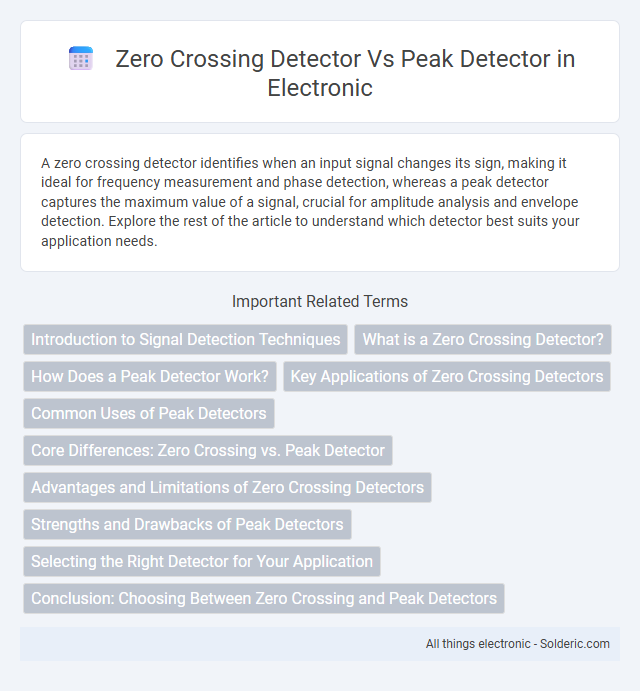A zero crossing detector identifies when an input signal changes its sign, making it ideal for frequency measurement and phase detection, whereas a peak detector captures the maximum value of a signal, crucial for amplitude analysis and envelope detection. Explore the rest of the article to understand which detector best suits your application needs.
Comparison Table
| Feature | Zero Crossing Detector | Peak Detector |
|---|---|---|
| Function | Detects when the input signal crosses zero voltage level | Captures and holds the maximum (peak) value of the input signal |
| Application | Frequency measurement, phase detection, signal timing | Envelope detection, signal amplitude measurement, audio processing |
| Output | Digital-like pulse at zero crossing points | DC voltage proportional to peak input signal |
| Input Signal | AC or time-varying signals crossing zero | Any time-varying signal with peaks |
| Circuit Complexity | Simple comparator-based circuit | Peak detector diode and capacitor circuit |
| Response Time | Fast, limited by comparator speed | Depends on capacitor discharge rate, slower |
| Accuracy | High zero-cross detection accuracy | Dependent on diode drop and capacitor leakage |
Introduction to Signal Detection Techniques
Zero crossing detectors identify points where an input signal changes sign, providing precise timing information essential for phase-locked loops and frequency measurement. Peak detectors capture the maximum amplitude of a waveform, critical for envelope detection and amplitude modulation applications. Understanding these fundamental signal detection techniques enhances the accuracy and efficiency of your electronic signal processing tasks.
What is a Zero Crossing Detector?
A Zero Crossing Detector is an electronic circuit designed to identify the point where an input signal crosses the zero voltage level, indicating a change in its polarity. This device is crucial in applications requiring precise timing, such as phase-locked loops, frequency counters, and waveform shaping. Unlike Peak Detectors that measure signal amplitude extremes, Zero Crossing Detectors focus on temporal events marking signal transitions through zero voltage.
How Does a Peak Detector Work?
A peak detector works by capturing and holding the highest voltage level of an input signal, using a diode, capacitor, and operational amplifier to store this peak value until it is reset or updated by a higher signal amplitude. Unlike a zero crossing detector, which identifies the points where the waveform crosses the zero voltage level, the peak detector provides a continuous measurement of the maximum signal amplitude, crucial for applications like signal demodulation or envelope detection. Your choice between these detectors depends on whether you need to track signal peaks or detect timing events based on zero crossings.
Key Applications of Zero Crossing Detectors
Zero crossing detectors are commonly used in phase-locked loops (PLLs) for synchronization in communication systems and in frequency counters for precise waveform analysis. They play a critical role in motor control circuits to determine the optimal switching instance, reducing electromagnetic interference and improving efficiency. Additionally, zero crossing detectors are integral in waveform shaping applications, such as timing pulse generation and inverters, where accurate timing of alternating signal transitions is essential.
Common Uses of Peak Detectors
Peak detectors are commonly used in signal processing to capture and hold the maximum amplitude of a waveform for analysis and measurement purposes. Applications include audio signal level monitoring, envelope detection in communication systems, and voltage peak measurement in power supplies. Your choice between a zero crossing detector and a peak detector depends on whether you need to identify waveform timing or accurately measure signal peaks.
Core Differences: Zero Crossing vs. Peak Detector
Zero crossing detectors identify points where a signal waveform crosses the zero voltage level, making them ideal for timing and synchronization applications. Peak detectors capture and hold the maximum amplitude of a signal, crucial for amplitude measurement and signal analysis. The core difference lies in zero crossing detectors tracking signal transitions through zero volts, while peak detectors focus on the highest signal voltage reached.
Advantages and Limitations of Zero Crossing Detectors
Zero crossing detectors offer precise timing information by identifying when an input signal crosses the zero-voltage level, enabling accurate frequency measurement and phase detection in signal processing applications. Their main advantages include simplicity, high speed, and minimal distortion since they rely on threshold crossing rather than amplitude measurement. However, zero crossing detectors struggle with noisy signals and may produce false triggers, limiting their reliability in environments with significant signal distortion or varying signal amplitudes.
Strengths and Drawbacks of Peak Detectors
Peak detectors excel at capturing signal maxima, providing precise amplitude information critical for envelope detection in communication systems and audio processing. However, their accuracy is limited by diode forward voltage drops and response time, which can introduce errors in fast-changing or low-amplitude signals. Your choice of a peak detector should consider these imperfections alongside application needs for signal fidelity and speed.
Selecting the Right Detector for Your Application
Zero crossing detectors excel in timing and frequency measurement applications due to their precise detection of signal transitions at the zero voltage level, making them ideal for phase-locked loops and digital waveform analysis. Peak detectors, which capture and hold the maximum amplitude of a signal, are better suited for amplitude measurement tasks such as envelope detection in communication systems and sensor signal processing. Selecting the right detector depends on whether your application prioritizes accurate timing information or reliable amplitude tracking for optimal performance and signal interpretation.
Conclusion: Choosing Between Zero Crossing and Peak Detectors
Zero crossing detectors excel in timing and frequency measurement by identifying signal transitions at zero amplitude, making them ideal for phase-locked loops and waveform synchronization. Peak detectors capture maximum amplitude values, crucial for envelope detection, signal strength measurement, and amplitude modulation applications. Choosing between zero crossing and peak detectors depends on whether timing precision or amplitude tracking is the primary requirement in the signal processing task.
Zero crossing detector vs Peak detector Infographic

 solderic.com
solderic.com